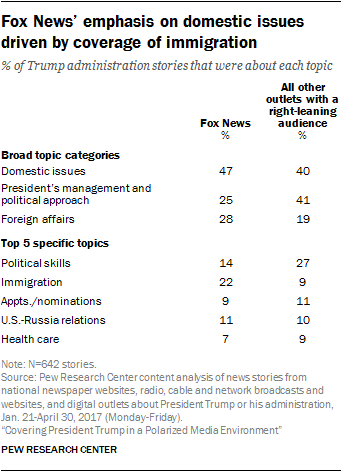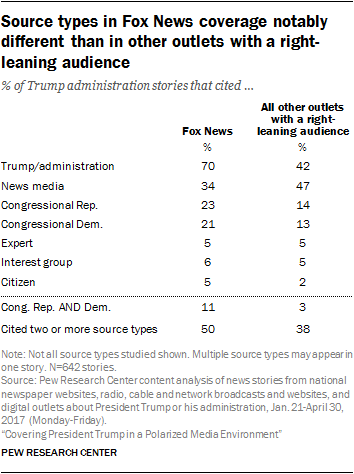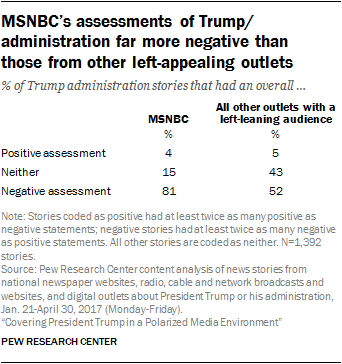 Of the 24 news media outlets included in this analysis, 12 have an audience that leans more left than right, five appeal to an audience more to the right than left and seven have an audience that is more mixed. In each of these three groups, it is possible to identify the outlet that produced the largest share of the content studied. In this study, the volume of content from any single outlet depends on a number of factors, including each outlet’s format, the amount of content produced and audience size. For outlets with an audience that leans to the right, one brand, Fox News, weighs particularly heavy because the study had fewer outlets that appealed to a right-leaning audience. For this reason, Fox News accounted for nearly half (49%) of all stories in this outlet group. CNN, one of seven more mixed-audience outlets, accounted for a little more than a third (37%) of all coverage in this group. While MSNBC had the greatest number of stories from any outlet with a left-leaning audience, it accounted for just 16% of the coverage, largely because there were 12 outlets in this group – more than the other two.
Of the 24 news media outlets included in this analysis, 12 have an audience that leans more left than right, five appeal to an audience more to the right than left and seven have an audience that is more mixed. In each of these three groups, it is possible to identify the outlet that produced the largest share of the content studied. In this study, the volume of content from any single outlet depends on a number of factors, including each outlet’s format, the amount of content produced and audience size. For outlets with an audience that leans to the right, one brand, Fox News, weighs particularly heavy because the study had fewer outlets that appealed to a right-leaning audience. For this reason, Fox News accounted for nearly half (49%) of all stories in this outlet group. CNN, one of seven more mixed-audience outlets, accounted for a little more than a third (37%) of all coverage in this group. While MSNBC had the greatest number of stories from any outlet with a left-leaning audience, it accounted for just 16% of the coverage, largely because there were 12 outlets in this group – more than the other two.
To understand how Fox News, CNN and MSNBC affected totals for each outlet group, researchers examined their coverage alongside the other news media included in the study. The differences that stood out are detailed below.
Fox News was more apt than other outlets appealing to a right-leaning audience to cover immigration, cite Trump/ administration sources and members of Congress, but less likely to be driven by the news media
 One area where Fox News differed from the remaining outlets in the group appealing to a right-leaning audience was in the share of coverage devoted to each of the three broad topic categories. Fox News devoted less of its coverage to the president’s management and political approach than did the remaining outlets with a right-leaning audience (25% vs. 41% of stories), and somewhat more of their stories were spent on domestic issues (47% vs. 40%) and foreign affairs (28% vs. 19%).
One area where Fox News differed from the remaining outlets in the group appealing to a right-leaning audience was in the share of coverage devoted to each of the three broad topic categories. Fox News devoted less of its coverage to the president’s management and political approach than did the remaining outlets with a right-leaning audience (25% vs. 41% of stories), and somewhat more of their stories were spent on domestic issues (47% vs. 40%) and foreign affairs (28% vs. 19%).
When it came to the specific storylines within these broad topic categories, Fox News devoted much more attention to immigration than other outlets with a right-leaning audience (22% vs. 9%) and less attention than others to the president’s political skills (14% vs. 27%).
 The sources audiences heard from in the Fox News cable and website content studied also differed in several ways from other outlets in this group. Seven-in-ten Fox News stories (70%) about President Trump or the administration cited the president or a member of his administration, compared with 42% of stories from the remaining outlets in this group. The network was also more likely than all other outlets with a right-leaning audience to cite a Democratic member of Congress and far more likely to cite both a Democrat and Republican Congress member in a story. Conversely, it was less likely to cite the news media as a source. And, overall, 50% of Fox News stories contained at least two different types of news sources, compared with just 38% of stories from other outlets that appeal to a right-leaning audience.
The sources audiences heard from in the Fox News cable and website content studied also differed in several ways from other outlets in this group. Seven-in-ten Fox News stories (70%) about President Trump or the administration cited the president or a member of his administration, compared with 42% of stories from the remaining outlets in this group. The network was also more likely than all other outlets with a right-leaning audience to cite a Democratic member of Congress and far more likely to cite both a Democrat and Republican Congress member in a story. Conversely, it was less likely to cite the news media as a source. And, overall, 50% of Fox News stories contained at least two different types of news sources, compared with just 38% of stories from other outlets that appeal to a right-leaning audience.
 As for what triggered a story, Fox News was about half as likely to produce stories that were initiated by the news media as the remaining outlets in that media grouping (18% vs. 32%).
As for what triggered a story, Fox News was about half as likely to produce stories that were initiated by the news media as the remaining outlets in that media grouping (18% vs. 32%).
Conversely, statements or actions by the president or his administration drove more of the coverage for Fox News (43%) than the other outlets with a right-leaning audience (31%).
One area of little difference between Fox News and other outlets whose audiences skew right was the evaluations the stories contained of Trump and his administration’s words or actions. Over half of all stories by Fox News (55%) and all other outlets with a right-leaning audience (56%) were neither positive nor negative, but positive assessments for each (30% and 32%) outweighed negative (15% and 12%) by about two-to-one.
CNN coverage focused more on U.S.-Russia relations and the president’s political skills, cited fewer experts and interest groups than other outlets with a mixed audience, and was more often triggered by Trump/administration
 One way CNN differed from all other more mixed-audience outlets was the cable network’s greater emphasis on foreign affairs.
One way CNN differed from all other more mixed-audience outlets was the cable network’s greater emphasis on foreign affairs.
Overall, foreign affairs accounted for 36% of CNN television and website content studied about Trump and his administration compared with 28% of coverage from the remaining outlets in this group. CNN also devoted less attention to domestic issues (32% vs. 41%, respectively).
The prevalence of CNN’s foreign affairs coverage in part reflects a specific focus on the storyline of U.S.-Russia relations: 20% of all of CNN’s stories, compared with 12% of content from all other outlets with a more mixed audience. An additional one-in-five stories from CNN focused on the president’s political skills (20%) compared with 14% from other more mixed-audience outlets.
 Another way CNN stood out from all other outlets with a more mixed audience was in how likely its coverage was to offer a negative assessment of President Trump and his administration’s words or actions.
Another way CNN stood out from all other outlets with a more mixed audience was in how likely its coverage was to offer a negative assessment of President Trump and his administration’s words or actions.
Over half of CNN’s coverage was negative (56%) while almost four-in-ten stories (38%) were neither positive nor negative. In contrast, coverage from other outlets in this group was less likely to be negative (42%) than to be neither positive nor negative (52%).
When it came to the sources cited, a few differences also stand out. CNN was about half as likely as all other outlets with a more mixed audience to cite an expert (8% compared with 20%). They were also three times less likely to source an interest group in their stories (6% compared with 18%). Roughly half (54%) of CNN’s stories included two or more source types, compared with about two-thirds (67%) of coverage from other, more mixed-audience outlets.
When considering what triggered CNN’s coverage compared with all other more mixed-audience outlets, there was little difference except for how often CNN responded to actions or statements by Trump and his administration. Over half (54%) of all stories by CNN were in response to something Trump or his administration did or said, slightly higher than all other outlets appealing to a more mixed audience (48%).
MSNBC’s coverage was considerably more negative, less likely to cite experts and interest groups, and focused more on U.S.-Russia relations and Trump’s political skills than other outlets with left-leaning audience
 The most striking difference between MSNBC’s coverage and that from all other outlets with a left-leaning audience was in the assessments the stories offered of President Trump and his administration’s words or actions.
The most striking difference between MSNBC’s coverage and that from all other outlets with a left-leaning audience was in the assessments the stories offered of President Trump and his administration’s words or actions.
About eight-in-ten (81%) of MSNBC’s stories offered an overall negative assessment of Trump and the administration, compared with about half (52%) of stories from other outlets in this group.
Stories from MSNBC were also less likely to have neither a positive nor a negative assessment than stories from other outlets with a left-leaning audience (15% vs. 43%).
 Another notable difference is that MSNBC’s viewers were more likely to hear from other news outlets and less likely to hear from experts and interest groups than audiences of other outlets in this group.
Another notable difference is that MSNBC’s viewers were more likely to hear from other news outlets and less likely to hear from experts and interest groups than audiences of other outlets in this group.
Close to half (48%) of MSNBC’s coverage included another news organization as a source for stories compared with 38% of stories from all other outlets in this group.
MSNBC was also far less likely than other outlets in this group to cite an expert (3% vs. 26%) or an interest group (3% vs. 18%).
Additionally, MSNBC was less likely to cite a Democratic member of Congress (17% vs. 22%) or to include both a congressional Democrat and Republican (8% vs. 15%) as a source in the same story than all other outlets in this group.
 MSNBC’s viewers also heard more about foreign affairs – especially U.S-Russia relations – than did audiences who turned to other outlets with a left-leaning audience.
MSNBC’s viewers also heard more about foreign affairs – especially U.S-Russia relations – than did audiences who turned to other outlets with a left-leaning audience.
MSNBC covered foreign affairs at a higher rate than did the rest of the outlets in this group (31% vs. 23%), but stories were less focused on domestic issues (33% vs. 42%). But both MSNBC and the remaining outlets in this group covered the president’s management and political approach at about the same rate (37% vs. 35%).
MSNBC’s greater emphasis on foreign affairs was driven largely by its coverage of U.S.-Russia relations (21%), which was about twice that of other outlets in this group (10%). MSNBC coverage was also somewhat more likely to include stories about the president’s political skills (20%) than other outlets with a left-leaning audience (15%).
Overall, coverage from left-appealing outlets was most often produced in response to actions or statements from President Trump or his administration. However, about half (51%) of MSNBC’s coverage was in response to the president or his administration, higher than other outlets with a left-leaning audience (44%). MSNBC was somewhat more likely to have stories driven by a member of Congress than other outlets in this group (15% vs. 9%, respectively).


